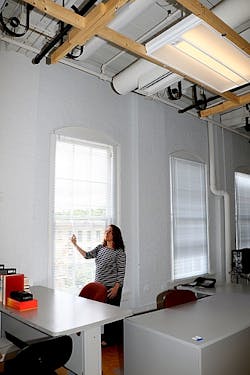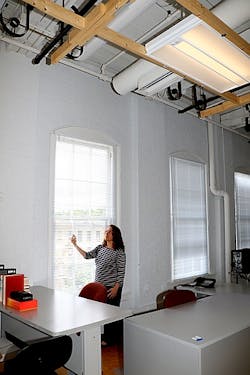A report created by the Lighting Research Center is posted on the Bonneville Power Administration website detailing tests of LED luminaires and control systems in open office and conference room spaces.
The Lighting Research Center (LRC) at Rensselaer Polytechnic Institute has announced the release of a report on pilot tests of dimmable LED luminaires and adaptive controls in an actual office environment. The Bonneville Power Administration (BPA), a US Department of Energy (DOE) agency that operates the Federal Columbia River Power System, commissioned the research and released the full report on its website. The researchers found that the connected lighting systems were difficult to commission and also at times frustrating for workers to use once installed, but the solid-state lighting (SSL) systems definitely delivered energy savings based on occupancy-sensing and daylight-harvesting controls.
Interested in articles & announcements on lighting controls & connected lighting?
The initial "Easily commissioned lighting controls" report is actually part of the second phase of a project that was instigated in 2014 by BPA and the Washington State University Energy Program. The two sought to find emerging technologies that could lead to significant energy savings for the Northwest region of the US. In phase one, the LRC reported on a number of lighting control systems based on interviews with manufacturers and literature review.
Phase two sought to evaluate some of the lighting controls in an actual use case. The LRC worked with its Lighting Energy Alliance (PEA) partners including Efficiency Vermont, Energize Connecticut, and National Grid on the installation and trial. BPA sought to understand the complexity of installation and commissioning, how typical systems worked, the differences between dedicated sensors that control zones of luminaires relative to luminaires with integral sensors, and the differences in power demand when different luminaires were connected to the various tested control systems.
The pilot involved the evaluation of three control systems that could be used with any 0–10V dimmable luminaire and also the Philips Lighting SpaceWise linear luminaires that have integral sensors and control system. The other three systems include Cree SmartCast, Lutron Energi TriPak, and Wattstopper DLM Zone. Those systems were installed with assorted wireless sensors, switches, and dimming modules. Moreover, each of the three control platforms was tested with linear luminaires from Cree, Philips Lighting, and Lithonia Lighting (Acuity Brands).
The results of the pilot test thus far are mixed. Generally, the research team said technicians were able to easily install the control systems and luminaires. But commissioning proved complex in every case. The report notes that documentation for the commissioning process was perhaps not in final form when the team acquired the products with all of the platforms having been relatively new at the time. Form the most part, the team had to request assistance from the manufacturers or their representatives to complete the commissioning.
The frustration for workers that have occupied the space lit for the project has been centered around light levels. The report said none of the control platforms tested offered a way to adjust the ratio of the light level detected by the sensor to the task light produced. The result has in many cases been levels too low for worker comfort. Some of the systems, however, allow manual override to raise the light level and those were favored by users of the space.
The news on the energy-efficiency front is much brighter. The report said the sensor-based systems deliver significant additional energy savings relative to time-clock-based programmatic control. Systems that require a manual turn-on action deliver even more energy efficiency compared to those with automatic turn-on.
In the comparison of zone-based sensors to integrated sensors, the report states no conclusive preference in terms of use case or power used. Instead, the report said that choice is dependent on the application and room configuration.
Testing three different luminaire types enabled the researchers to conclude that energy usage can be quite different based on the driver in each luminaire model. Dim levels don't match up from product to product in terms of light produced or energy used.
And the report noted that when dimmed, all of the tested products exhibited power factor below the magic 0.9 level required by regulatory and market-transformation programs. Since the luminaires would likely be operated at less than 100% most of the time, the power factor may or may not be an issue. The report notes that severe drops in power factor happen at very low light levels where the luminaires are drawing far less power in any case and therefor the impact on a utility might be insignificant.
The research on controls and energy use has been led by LRC lighting scientist Leora Radetsky. "These intelligent luminaires with integrated sensors and controls promise ideal light levels on the workplane with significant energy savings," said Radetsky. However, the SSL industry is clearly still maturing when it comes to smart lighting and adaptive controls. Radetsky also said she is testing three additional systems and hopes to publish those results by the end of the year.
You can view the 45-page report in its entirety on the BPA website. It documents the specific commissioning issues with each of the platforms and the operational experience of each with all of the luminaire types.






